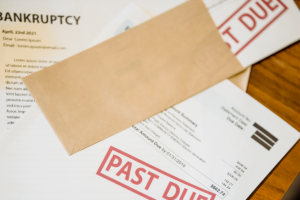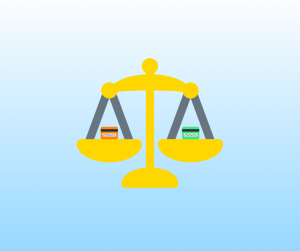Derogatory Credit Marks—Grow From Bad to Great Credit

What Are Credit Scores?
09/25/2023
Credit Reports: What You Need to Know
10/05/2023The right credit score can help you sail through smooth financial waters. But if you have a bad credit score, it’s often more difficult to access the financing opportunities you need. Plus, those with a lower credit score tend to pay more in interest, which can add up to thousands of dollars over the course of a loan.
If a good credit score is a priority for you, a derogatory mark is the last thing you want to see on your credit report. Unfortunately, a derogatory mark could spell trouble for your credit score.
Let’s explore what a derogatory mark is, how long it might impact your credit score, and how to rebuild your credit.
What Are Derogatory Credit Marks?
Derogatory credit marks are negative items on your credit report. When a derogatory mark hits your credit report, it won’t be a permanent fixture. However, most derogatory marks take years to fall off of your credit report.
The result of a derogatory mark is a negative impact on your credit score. Most derogatory marks pull your credit score down.
What Actions Lead to a Derogatory Mark on Your Credit Report?
Derogatory credit marks tend to crop up after you make a misstep while repaying a loan or credit card. If you don’t follow the agreed-upon terms with the lender, you are likely to see a derogatory mark crop up on your credit report.
Below is a closer look at some of the most common types of derogatory marks you might see on your credit report.
Late Payments
When a late payment hits your credit report, it’s considered a derogatory mark. Your payment history can have a big impact on your credit report. In fact, your payment history accounts for 35% of your FICO score, which makes it the most important factor.
A late payment can drag your credit score down. But the good news is that a late payment is considered a minor derogatory mark—if you can catch up on payments quickly. Plus, you’ll have some time to make a payment after the deadline before this negative information hits your credit report.
Late payments don’t appear on your credit report until you’re at least 30 days late. For example, if you missed the deadline by a week due to a missed reminder, that shouldn’t hit your credit report as a derogatory mark. But if you miss the payment deadline by a month or more, you’ll see the consequence appear on your credit report.
That doesn’t mean you’re off the hook with your lender if you’re late by less than 30 days—you will likely face consequences imposed by your lender, such as a late fee or an increased interest rate—but as far as your credit, you have a 30-day grace period before your reports and scores take a hit.
Accounts in Collections
When you don’t pay your lender on time, they might sell the bill to a collections agency. Typically, this doesn’t happen until you’ve missed several payments and haven’t found a new solution with the lender.
You might be able to avoid this derogatory mark by communicating with your lender before they send the account to collections. Some lenders are willing to rework your payment plan or make other adjustments to help you avoid a hit to your credit while you get your payments back on track.
If you are experiencing a financial hardship that might cause you to miss payments, it’s never a bad idea to communicate the situation with your lender. You never know who might be willing to offer a lifeline for your credit.
Civil Judgments
A civil judgment stems from a civil lawsuit. If you lose the case, you might be required to pay for damages or cover debt payments. In some situations, a civil judgment may appear on your credit report.
Bankruptcy
Bankruptcy is often a last resort for borrowers carrying a heavy debt burden. If you choose to file for bankruptcy, either option will likely hurt your credit score significantly. However, the type you choose will impact how long the information stays on your credit report.
The end result of bankruptcy is to discharge eligible debts and sell your assets to repay select lenders. Before moving forward with this specialized legal procedure, seek advice from a legal professional.
Foreclosure
A foreclosure happens after you fall behind on your mortgage payments. In most cases, you’ll need to fall behind on the payments by several months to experience foreclosure. If the lender forecloses on your mortgage, the lender will repossess your property.
Of course, no one wants to deal with the emotional and logistical fallout of a foreclosure. But even after the dust has settled, this uncomfortable event will remain on your credit report as a derogatory mark. Many mortgage lenders will choose not to work with you for as long as this mark appears on your credit report.
Debt Settlement
A debt settlement involves paying back less than you originally owe to satisfy a lender. While a debt settlement might be the right move for your budget, the choice will appear as a derogatory mark on your credit report.
For most, the priority of a debt settlement is to get out of debt faster. And that’s often a great move. However, it can negatively impact your credit score and potentially impact your future access to affordable financing opportunities.
Tax Lien
If you don’t pay your taxes on time, the government can put a lien on your assets. In some cases, this information can show up on your credit report. While most federal tax liens aren’t put directly on your credit report, many lenders conduct a public search for tax liens before committing to a loan.
How Long Does a Derogatory Credit Mark Impact Your Credit?
In general, derogatory marks hang out on your credit reports for up to seven years. Below is a breakdown of how long you can expect a derogatory credit mark to continue impacting your credit.
- Late payments: Late payments can stay on your credit report for up to seven years.
- Accounts in collections: Accounts in collection stay on your credit report for up to seven years. If you pay off the account during that seven-year window, the mark will remain on your credit report, but the listing will change to a “paid account.”
- Civil judgment: If you pay the civil judgment, it will likely fall off your credit report seven years after it was filed. If you don’t pay the civil judgment within seven years, it might stay on your credit report for longer.
- Chapter 7 bankruptcy: Filing a Chapter 7 bankruptcy can remain on your credit report for up to 10 years.
- Chapter 13 bankruptcy: Filing a Chapter 13 bankruptcy can remain on your credit report for up to seven years.
- Foreclosure: A foreclosure may stay on your credit report for up to seven years.
- Debt settlement: A debt settlement can stay on your credit report for seven years from the day you settle the debt.
- Tax lien: An unpaid tax lien can stay on your credit report until you pay it off. But a paid tax lien will fall off your credit report seven years from the filing date.
Seven years is an extensive period of time to have your credit score reflect a one-time mistake. Whenever possible, do your best to avoid letting a derogatory mark hit your credit report.
However, the negative impact of a derogatory mark lessens over time, and it is possible to work your way up to a good credit score even with a derogatory mark or two on your credit report.
How to Build Credit After Derogatory Marks Hit Your Credit Report
If a derogatory mark has hit your credit report, it’s not the end of the world. Think of it as the beginning of your new credit-building journey. Below are some steps you can take to rebuild your credit score.
Look at Your Credit Report
The first step is to take a close look at your credit reports. You can get free copies of your credit reports through AnnualCreditReport.com.
Once you have the reports, run through them with a fine-tooth comb. Confirm that all of the information is correct, especially when it comes to derogatory credit marks.
Dispute Any Errors on Your Credit Report
Unfortunately, mistakes happen. Whether a lender mistakenly reported a late payment or a fraudster ran up a credit card balance using your information, mistakes on your credit report often don’t have a good outcome for your credit score.
Luckily, you have the opportunity to dispute any mistakes on your credit report. For example, if you spot fraud activity on your credit report, you can file a claim with the appropriate credit bureaus.
When you file your report, provide as much information as possible. Once you dispute the error, the credit bureau has 30 days to investigate the issue. Hopefully, the credit bureau’s investigation will agree with your assessment. Generally, any errors will be updated within a few weeks.
Focus On Making On-time Payments
Even if you remove incorrect information from your credit report, you may still need to add positive information. One manageable way to add positive information to your credit report is to make on-time payments a priority. As you build a history of on-time payments, you’ll also build your credit score.
If you struggle to remember payment deadlines, take advantage of automatic payment options. Many lenders allow you to set up automatic payments, which can help ensure that you always pay your bills on time.
If you are struggling to make on-time payments due to cash flow issues, it’s time to take a closer look at your budget. Depending on your situation, you might have an income or spending problem. As you make adjustments, consider reaching out to your lender. If you know you won’t be able to make a payment on time, let them know. Some lenders might be willing to extend the deadline while you get back on your feet.
Add Credit Accounts
Credit tradelines include all types of credit accounts that appear on your credit report. For example, an auto loan and a credit card account would both appear on your credit report at credit tradelines.
Opening credit tradelines and managing them responsibly can have a positive impact on your credit score. If you are getting started with bad credit, you might consider opening a credit-builder loan or becoming an authorized user on a credit card account in good standing.
Make it a priority to manage these new tradelines responsibly. Start by making on-time payments and keeping your credit utilization ratio on the lower end.
Be Patient
Building credit doesn’t happen overnight. It will likely take time to see the fruits of your labor. That’s especially true if you have derogatory marks on your credit report. It may take years for these derogatory marks to fall off your credit report, but you can still improve your credit in the meantime.
As you embark on your credit-building journey, be patient with the process. If you stick to responsible credit management habits, you’ll see your credit score grow over time.
FAQs
Can a Derogatory Mark Be Removed From Your Credit Report?
If an inaccurate derogatory mark hits your credit report, you can dispute the issue with the credit bureaus. However, you can only have inaccurate derogatory marks removed. If an accurate derogatory mark appears on your credit report, you’ll have to wait for it to fall off your credit report.
How Much Does a Derogatory Mark Affect Credit?
The type of derogatory mark on your credit report will impact how much it affects your credit. A significantly negative item, like a foreclosure or bankruptcy, could lead to a plummeting credit score.
Can You Still Buy a House With Derogatory Marks?
It’s still possible to buy a house with derogatory marks on your credit report. Of course, the lender will take a look at your derogatory marks. The lender determines whether or not to move forward with your loan application.
The Bottom Line
Derogatory credit marks can have a big impact on your credit score. Unfortunately, derogatory marks will always push your credit score in the wrong direction. The good news is that you can take action to improve your credit score despite the negative information.
Don’t wait! Start taking steps to improve your credit score today.





